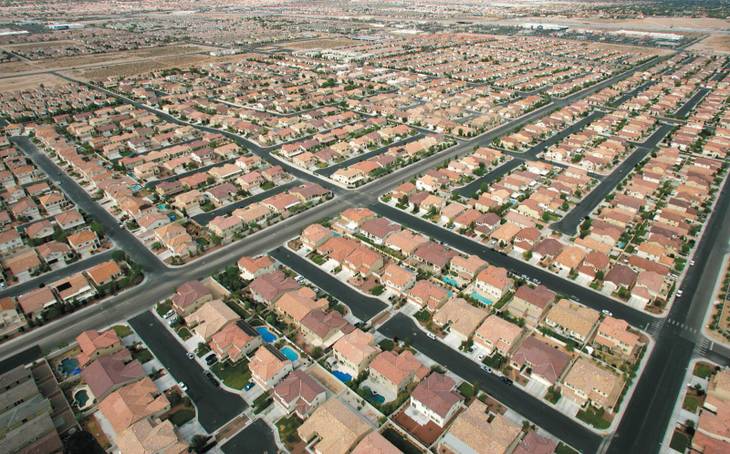Despite the slowly improving U.S. economy, more than half of Nevada households are locked in “perpetual financial insecurity,” says a new report, as the state remains near the bottom of the pack nationally for residents’ financial health.
Nevada has some of the highest rates of bankruptcy filings, underemployment, delinquent mortgages, uninsured residents and student-loan defaults, according to the nonprofit Corporation for Enterprise Development, or CFED.
The state also has some of the lowest rates of high school graduation, residents with college degrees, early childhood education enrollment, strong consumer-credit scores and small-business ownership.
CFED outlined these and other findings Monday in its annual Assets & Opportunity Scorecard.
It’s the latest national study to highlight Nevadans’ weak personal finances, and yet another report — whether it’s analyzing foreclosures, underwater homeowners, doctor shortages or domestic violence — to rank Nevada or Las Vegas among the worst in the country.
Overall, CFED ranked Nevada 48th among the states and the District of Columbia for residents’ financial security. That was unchanged from last year’s ranking but a few notches better than in 2013, when Nevada was dead-last.
At the time, CFED said the majority of residents here were living “on the edge of financial disaster” with almost no savings to fall back on.
Vermont ranked No. 1 in Monday’s report, while only Georgia (49th), Alabama (50th) and Mississippi (51st) were lower than Nevada.
“There certainly are positive signs that the nation’s economy is improving,” CFED President Andrea Levere said in a news release. “But there also is very compelling evidence that many households are stuck in a financial hole and are struggling to dig themselves out.”
According to the advocacy group for lower-income Americans, 56 percent of Nevada households “are locked into a ‘new normal’ of perpetual financial insecurity, unable to build the savings needed to last even three months in the event of an emergency.”
The situation, however, “is most dire for households of color,” the group reported.
Black and Hispanic households in Nevada are “significantly more likely” to live below the federal poverty line than white households, and “even most startlingly” is that white-owned businesses statewide are valued almost nine times higher than black-owned businesses, CFED reported.
CFED, based in Washington, D.C., analyzed dozens of issues under five main categories for each state and the nation’s capital. Nevada received a “D” in four of the categories and an “F” in the other — financial assets and income (D), businesses and jobs (F), housing and homeownership (D), health care (D) and education (D).
CFED also analyzed state policies that, it says, would boost residents’ financial health. Nevada fared better with this, ranking 31st in the country for policies related to the Scorecard’s five main categories.
Here is a sampling of CFED’s findings about Nevada; how these issues rank nationally; and how they compare to the U.S. as a whole:
Financial Assets and Income
• Unbanked households: 7.9 percent (32nd-best in the country) vs. 7.7 percent nationally
• Underbanked households: 24.7 percent (44th) vs. 20 percent
• Consumers with prime, or strong, credit: 39.4 percent (48th) vs. 48.9 percent
• Bankruptcy rate (filings per 1,000 people): 3.8 (45th) vs. 2.9
Businesses and Jobs
• Small-business ownership rate: 1.19 percent (50th) vs. 1.38 percent
• Underemployment rate: 14.8 percent (51st) vs. 10.8 percent
• Average annual pay: $45,547 (39th) vs. $51,364
• Employers offering health insurance: 53 percent (9th) vs. 47.5 percent
Housing and Homeownership
• Homeownership rate: 53.6 percent (49th) vs. 63.1 percent
• Delinquent mortgage loans: 2.38 percent (44th) vs. 1.86 percent
• High-cost mortgage loans: 11.7 percent (51st) vs. 7.1 percent
Health Care
• Uninsured rate: 17.4 percent (46th) vs. 13.5 percent
• Uninsured low-income children: 12 percent (48th) vs. 8.2 percent
• Forgoing doctor visit due to cost: 17.2 percent (42nd) vs. 14.3 percent
Education
• Early childhood education enrollment: 34 percent (49th) vs. 47.1 percent
• High school graduation rate: 70 percent (49th) vs. 82.3 percent
• High school degree: 85.1 percent (44th) vs. 86.9 percent
• Two-year college degree: 31.2 percent (46th) vs. 38.2 percent
• Four-year college degree: 23.1 percent (46th) vs. 30.1 percent
• College graduates with debt: 46 percent (1st) vs. 61 percent
• Student-loan default rate: 14.3 percent (42nd) vs. 11.8 percent
